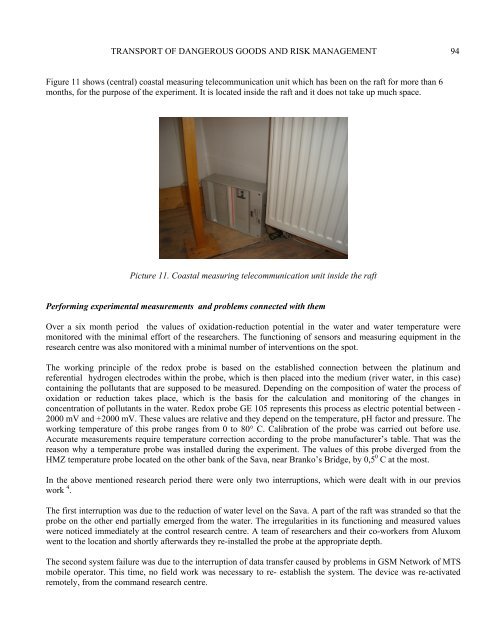transport of dangerous goods and risk management - Kirilo SaviÄ
transport of dangerous goods and risk management - Kirilo SaviÄ
transport of dangerous goods and risk management - Kirilo SaviÄ
Create successful ePaper yourself
Turn your PDF publications into a flip-book with our unique Google optimized e-Paper software.
TRANSPORT OF DANGEROUS GOODS AND RISK MANAGEMENT 94Figure 11 shows (central) coastal measuring telecommunication unit which has been on the raft for more than 6months, for the purpose <strong>of</strong> the experiment. It is located inside the raft <strong>and</strong> it does not take up much space.Picture 11. Coastal measuring telecommunication unit inside the raftPerforming experimental measurements <strong>and</strong> problems connected with themOver a six month period the values <strong>of</strong> oxidation-reduction potential in the water <strong>and</strong> water temperature weremonitored with the minimal effort <strong>of</strong> the researchers. The functioning <strong>of</strong> sensors <strong>and</strong> measuring equipment in theresearch centre was also monitored with a minimal number <strong>of</strong> interventions on the spot.The working principle <strong>of</strong> the redox probe is based on the established connection between the platinum <strong>and</strong>referential hydrogen electrodes within the probe, which is then placed into the medium (river water, in this case)containing the pollutants that are supposed to be measured. Depending on the composition <strong>of</strong> water the process <strong>of</strong>oxidation or reduction takes place, which is the basis for the calculation <strong>and</strong> monitoring <strong>of</strong> the changes inconcentration <strong>of</strong> pollutants in the water. Redox probe GE 105 represents this process as electric potential between -2000 mV <strong>and</strong> +2000 mV. These values are relative <strong>and</strong> they depend on the temperature, pH factor <strong>and</strong> pressure. Theworking temperature <strong>of</strong> this probe ranges from 0 to 80° C. Calibration <strong>of</strong> the probe was carried out before use.Accurate measurements require temperature correction according to the probe manufacturer’s table. That was thereason why a temperature probe was installed during the experiment. The values <strong>of</strong> this probe diverged from theHMZ temperature probe located on the other bank <strong>of</strong> the Sava, near Branko’s Bridge, by 0,5 0 C at the most.In the above mentioned research period there were only two interruptions, which were dealt with in our previoswork 4 .The first interruption was due to the reduction <strong>of</strong> water level on the Sava. A part <strong>of</strong> the raft was str<strong>and</strong>ed so that theprobe on the other end partially emerged from the water. The irregularities in its functioning <strong>and</strong> measured valueswere noticed immediately at the control research centre. A team <strong>of</strong> researchers <strong>and</strong> their co-workers from Aluxomwent to the location <strong>and</strong> shortly afterwards they re-installed the probe at the appropriate depth.The second system failure was due to the interruption <strong>of</strong> data transfer caused by problems in GSM Network <strong>of</strong> MTSmobile operator. This time, no field work was necessary to re- establish the system. The device was re-activatedremotely, from the comm<strong>and</strong> research centre.








